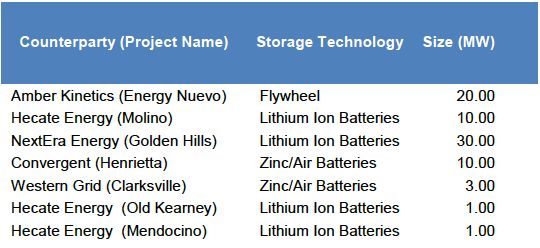In choosing their first round of procurements to meet the state’s 1.3-gigawatts-by-2020 energy storage mandate, California’s big investor-owned utilities have largely stuck to tried-and-true lithium-ion batteries -- until now. On Wednesday, Pacific Gas & Electric revealed contracts for 75 megawatts of storage that includes 20 megawatts of flywheels from startup Amber Kinetics and 10 megawatts of zinc-air batteries from Eos Energy Storage amidst the expected lithium-ion winners.
PG&E picked the winners from a list of applicants that added up to more than 50 times the amount of storage it first requested back in its December 2014 request for offers. It’s the utility’s first round of procurements mandated by AB 2514, the state law that set the 1.3-gigawatt requirement in place, and will be submitted to the California Public Utilities Commission for review and approval.

Lithium-ion batteries still make up the majority of the projects. They include a 30-megawatt system from NextEra Energy at its Golden Hills wind farm near Livermore, a 10-megawatt battery from Hecate Energy to support PG&E’s Molino substation near Sebastopol, and two more Hecate projects, 1 megawatt apiece, at two of the five strategic substations PG&E identified in its initial request for offers.
But its 20-megawatt procurement with Amber Kinetics is PG&E’s first foray into flywheels, the utility noted in its Wednesday announcement. Flywheels store energy in heavy, highly controlled, fast-spinning drums, and have usually been designed to deliver massive bursts of power over short durations.
But Amber Kinetics says its technology, based on research from Lawrence Livermore National Laboratory, can minimize the air drag, mechanical friction and electrical resistance that cause “coasting losses” in other flywheels, enabling multi-hour storage. The company's Energy Block, a storage container filled with steel-core flywheel systems, is rated at 80 kilowatts and 320 kilowatt-hours, meaning it can provide up to 4-hour charge-discharge cycles.
The Union City, Calif.-based startup has been working with the Department of Energy and the California Energy Commission (CEC) since 2011 to test its flywheels. This March 2012 DOE report (PDF) goes into great detail on the company’s technology and performance data, and this September 2012 review submitted by CEO Ed Chiao (PDF) claims the company can halve costs compared to traditional flywheels.
The two zinc-air battery projects, meanwhile, add up to one of the first sizable utility buys for a technology that’s largely been used in pilot projects or independent off-grid deployments to date. Zinc is cheap and plentiful, and it's used in many non-rechargeable batteries today, but it tends to break down after just hundreds of charge-discharge cycles.
A long list of companies are working on solving this challenge, whether with flow battery designs or the use of aqueous electrolytes. While PG&E didn’t name the zinc-air vendor in question, it’s likely to be Eos Energy Storage, given that PG&E has been testing the startup’s batteries at its San Ramon test lab in a CEC-funded pilot project launched early this year.
Convergent Energy + Power, the developer of the 10-megawatt zinc-air project, is indeed using Eos’ batteries, Convergent CEO Johannes Rittershausen said in a Thursday interview. The project will be rated at 40 megawatt-hours, or four hours of storage capacity, which allows it to meet the utility’s resource adequacy requirements, he said. Convergent will own and operate the project under an energy storage agreement with PG&E, akin to a power-purchase agreement from a generator, he said.
PG&E has dubbed that project “Henrietta,” referring to the substation it will be associated with, he said. That’s also near the 100-megawatt Henrietta solar farm, now being built by SunPower under a long-term power-purchase agreement with PG&E, indicating it could be used to meet some of the utility's solar-related needs as laid out in its initial request for offers (RFO). The second 3-megawatt zinc-air battery is being deployed by developer Western Grid at PG&E’s Clarksville substation near Folsom.
PG&E didn’t specify megawatt-hour figures for its projects, or discuss how it intends to use its new flywheel and zinc-air storage assets. The utility’s RFO did provide some duration requirements for different projects -- its substation batteries have to provide two hours of storage every day, for example, while its solar-connected projects have a four-hour duty cycle. But other projects, like the Amber Kinetics deployment site, dubbed “Energy Nuevo,” don't fit neatly into the RFO’s categories.
Greentech Media will be delving into the details of California's big utility storage deployments and other key issues for the fast-growing grid battery industry at its Energy Storage Summit next week in San Francisco. Click here to learn more about the conference, or to watch the livestream.



